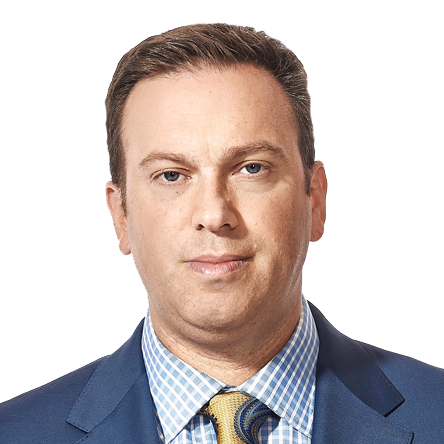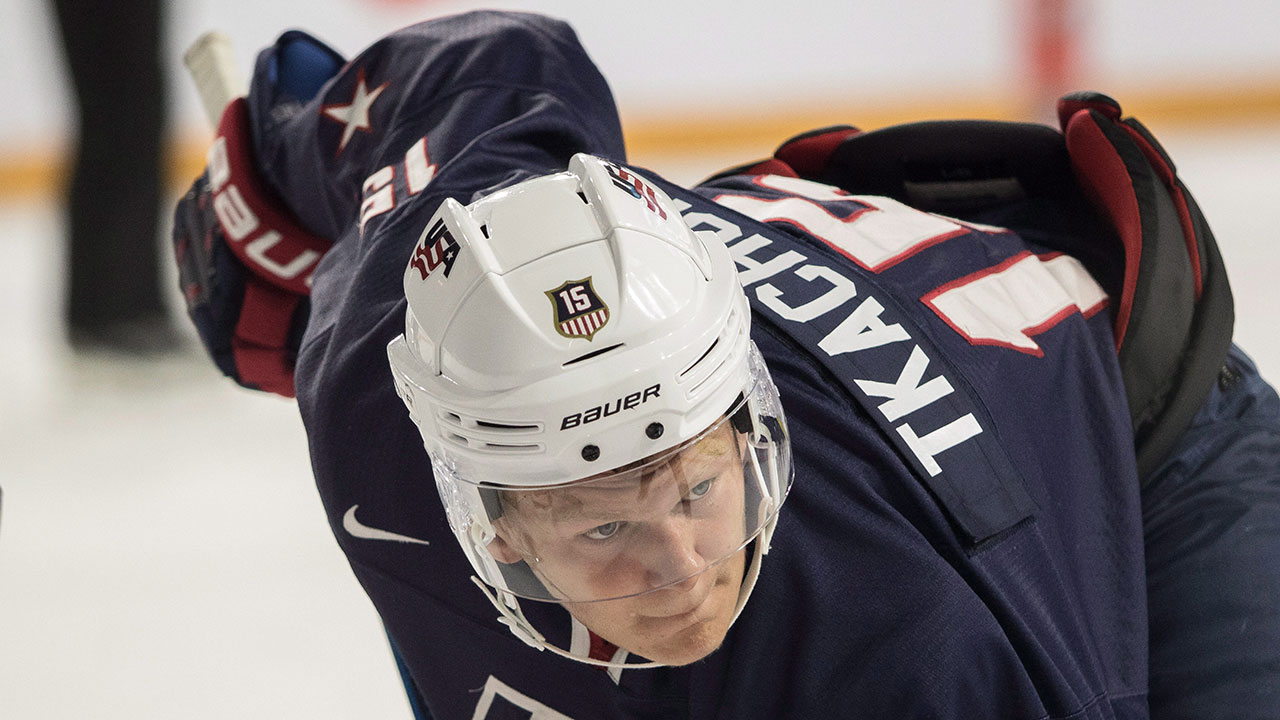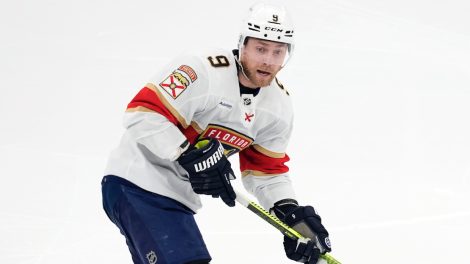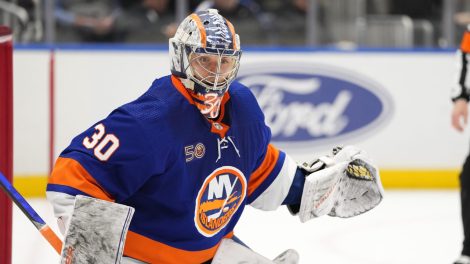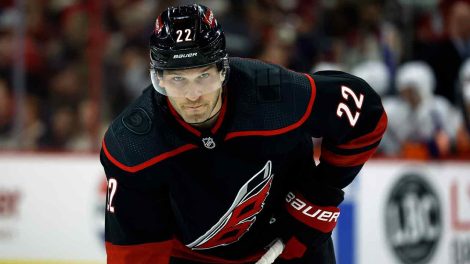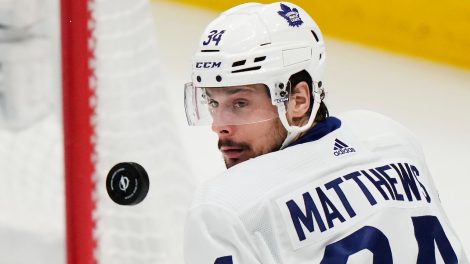So, what to make of NBA Commissioner Adam Silver’s New York Times Op-Ed calling for the legalization of professional sports betting across the United States?
“It means,” one NHL executive said Friday, “He thinks we’re going into Las Vegas, and he wants to be a part of it.”
My bet: that’s not a minority opinion.
Las Vegas Arena is 531 days from completion. According to its website, “The Arena will be the most sought-after venue to hold events. From red-carpet events to concerts, Awards shows to boxing events and UFC — Las Vegas Arena will set a new bar for what entertainment means in the city that knows it best.”
There’s no mention of hockey in that sentence, but, under seating capacities, it’s there. Boxing/UFC: 20,000-plus. Hockey: 17,500. Basketball: 18,800. Concerts: 12,000 to 19,600 (depending upon stage configuration). That’s a good number for the NHL, I think. No need for 19,000 seats here.
The NHL is denying reports that its already approved William Foley and the Maloof family as owners of a provisional franchise, but with the arena almost two years away, the league has time. And, my favourite Lou Lamoriello saying is, “If you have time, use it.”
So they will.
According to a couple of sources, if you can do $1.2 million gross revenue per game in your building, you’re going to be financially sound enough to run an NHL team. In Las Vegas, you’re not getting much from parking. Everyone walks the strip, or, if they have to, takes a cab.
You’re unlikely to get a ton of local television revenue. The building already has an owner. And, as Deputy Commissioner Bill Daly admitted to The Minneapolis Star-Tribune’s Michael Russo, the league is wondering if there are enough casual fans in the region. (Russo did not say if Daly was playing $1,000-a-hand blackjack tables while doing this “research.”)
The NHL’s biggest benefit to MGM and AEG (the builders of this new arena) is an anchor tenant. UFC president Dana White claims his organization will have the first event at the new facility, but that’s a one-off. You’re not getting 45 nights of sweaty grappling.
This is going to be the most modern facility on the strip. An NHL team may not drive revenue like a run of Nicki Minaj or Taylor Swift concerts, but if people/casinos are going to pay premium prices you need to be able to show an event schedule. Hockey helps you do this. That has an effect on signage, concessions, suite and premium-seating values.
Ticket prices in Vegas are not cheap. You want to go see “O” at the Bellagio? Starts at $131. You want to see Penn & Teller (guilty)? Three rows from the front is $116. Even if NHL tickets are given as comps to the high-rollers, the casinos are still paying the face value to the team owners.
That’s a good start on revenue. A really good start. What Daly is asking here, though, is who will use those tickets? Will it be the high-rollers themselves? Families? Wives? Girlfriends? Wives and girlfriends?
It’s a good question. You want in-arena revenue. You don’t want wide swaths of empty seats.
After what happened with the NBAs Sacramento Kings, I don’t understand why the NHL would want anything to do with the Maloofs. One source suggests it’s this: They know Vegas. They know how the business works. If they can help a hockey team work a deal where it gets a cut of overall suite revenue for being the anchor tenant, that’s valuable.
The gambling issue is a bigger deal for the NBA than the NHL because there’s not as much wagering on hockey games. That’s why Silver is getting in front of it. Whatever we may or may not know about the NHL in Las Vegas, guaranteed the NBA commissioner knows more.
He sees that his hockey compatriots are doing the legwork, getting in there first. He’s starting from behind, but he’s ready to race.
More NHL on Sportsnet:
Subscribe: Rogers GameCentre Live
Rogers Hometown Hockey | Broadcast Schedule
Sportsnet Fantasy Hockey Pool
30 THOUGHTS
1. If the NHL goes into Las Vegas, will it be an expansion team? There’s no need to answer that question now. With a couple years to wait, the league can decide if it will be expansion or if anyone needs to be moved.
2. Will the “dry scrape” survive the GM meetings? I personally don’t mind it, but there is concern about how many people are leaving.
3. With three-on-three overtime expected to be part of the discussion once again, an important thing to note is game length. Commissioner Gary Bettman has, in past meetings, indicated he does not want nights going longer. According to the American Hockey League, two more minutes of extra overtime has not increased game length in 2014-15. “Average time of game is up one minute so far this year, but in reality it’s down,” wrote AHL Vice-President, Communications Jason Chaimovitch in an email. “We do not include the shootout as part of game time, so last year the dry scrape (after OT) wouldn’t have counted, but this year (before OT) it does.”
4. Entering Thursday’s encounter with Boston, Montreal’s ice-time distribution on the power play was PK Subban (3:43 per game), Andrei Markov (3:29), Tom Gilbert (0:57) and Nathan Beaulieu (0:45). In Sergei Gonchar’s first game, Michel Therrien split up the Markov/Subban duo, going primarily with Gonchar/Markov and Gilbert/Subban. The ice-time went Subban (5:02), Gonchar (4:49), Markov (4:32) and Gilbert (3:55). Subban and Gilbert benefitted from a 2:11 shift, which boosted their total. Hard to imagine that cannon regularly being the third option.
5. In Montreal, there is debate now about Gilbert’s future. One thing about GM Marc Bergevin: he feels very strongly that you can never have too many defencemen, and, by adding Gonchar, he clearly believes Montreal didn’t have enough to begin with. The 40-year-old played 20 minutes in his debut, just his fourth game after missing the first 11 with an ankle injury. He’s been pretty durable (out just 17 games the past three years), but, at that age, can you afford to lean on him too heavily?
6. Gilbert, for the record, does not have no-trade protection. There was a lot of interest in him last summer in free agency. One of the pursuers was Detroit, although if Joan of Arc shot right, we’d be linking her to the Red Wings even though she died 600 years ago.
7. Bergevin made two roster changes (Travis Moen and Rene Bourque) almost immediately after word was he wanted to force Jiri Sekac into the lineup. This happens from time-to-time. Most GMs will tell you the coach deserves the right to set the individual game roster. A manager’s power is in creating that roster. (I’ve written before that one GM explained how, a few years ago, he traded two players so his coach would play younger guys. That duo is still together.) Besides, getting Sekac into a regular spot is working for everyone.
8. Watched Bergevin and Tampa Bay assistant GM Julien BriseBois on a panel last week at Concordia University’s John Molson School of Business. Some good life advice from both. BriseBois talked about how he shuts off his phone for one hour each weekday night during dinner with his family. That’s not easy for some executives (and reporters). “If it’s really an emergency,” he said, “people know to call me at home.” Bergevin: “If you are in your job for the money or the benefits, you look forward to Friday afternoon. If you’re in it for the passion, you look forward to Monday morning.”
9. Bergevin also had a great goodbye line: “If you have the urge to call me…fight it.” So far, no problem.
10. One of the reasons Jim Nill moved quickly? In his Dallas appearances, Gonchar’s ice time was fifth, fifth and sixth (by one second) among defenders. He was, at best, Lindy Ruff’s fourth option on the power play, and John Klingberg, making his NHL debut Tuesday, got 1:36 with the man advantage. It took Gonchar three games to reach that total. He is one of the NHL’s nicest people, but wouldn’t be happy in that situation. Nill was smart to move before it turned bad for everyone.
11. The Stars are 2-0 since the trade, impressively holding the Kings to just five third-period shots in Thursday night’s win. That is a good first step in eliminating some bad habits. One opposing coach: “They love track meets…willing to trade chances…they do have skill and are always four in the rush. Smart/patient/grinding teams counter-punch them and make them defend.”
12. The Stars are in a bit of a tough spot. Owner Tom Gagliardi did his part, spending on the roster. They gave Anaheim all the Ducks could handle last April and were a trendy dark-horse pick for 2015. They’ve got one home win. (“If you’re going to stink,” Gord Stellick always says, “Stink on the the road.”) My sense is Nill sees they’re getting there, but aren’t as ready to contend as the organization would like, especially on the back end. That’s why, in a desperate search for right-handed defenders, Klingberg gets the first chance, not an external acquisition. Better to save your assets if you believe the solution could be in-house. Klingberg looked really good against the Kings.
13. As the Ducks navigate through mumps and injury, GM Bob Murray indicated he will try to get through this without making a short-term move — even in goal. John Gibson is out another month with groin trouble. That leaves the net to Frederik Andersen and Jason LaBarbera, who came off the bench to beat Los Angeles 6-5 in a terrific shootout Wednesday night.
14. Not sure Edmonton can afford to be as patient in net. Wondered about an Ilya Bryzgalov return, but that appears unlikely. They are looking to see what’s out there, but Oilers are being careful. There’s no point in a short-term move for long-term cost either in goal or at centre.
15. Do not be surprised if Buffalo is also looking for a goalie or two, but on a more long-term basis. Both Jhonas Enroth and Michal Neuvirth are free agents after this season. Is either the Sabres’ long-term solution?
16. Scouting appearance that raised eyebrows: Ottawa’s Pierre Dorion at St. Louis/Rangers and Edmonton/Buffalo last week. Dorion obviously has a scouting background, but isn’t always out there, which is why it was noted. It’s no secret the Senators and Sabres, in particular, have spoken several times.
17. Definitely time for a fresh start for Colin Greening, in the lineup just four times this season. The Senators could have traded him before his September 2013 contract extension— it’s believed the Rangers and St. Louis were among those interested — but decided to keep him. Now, that makes it tougher.
18. Former St. Louis goalie coach Corey Hirsch on Ryan Miller: “Rollie Melanson has got him playing a lot smarter. He’s playing a little deeper in his net and not attacking so much. Teams were starting to pass around him he was so aggressive…He’s a deep thinker for a goalie, you always have to explain why something will or won’t work for him. He’s still very talented, but I thought he was really behind in new goaltending techniques and saves.”
19. Can you give more detail on that? “Yes, his post work…. Rollie’s a big one-knee down on the post guy. (Miller) is using it at the proper times now. On net drives only. He used to use it everywhere.” Hirsch added that Miller also occasionally raised his knee in the butterfly, which opened his five-hole. Melanson has worked on that, too.
20. Ran that assessment by another goalie coach, who agreed with Hirsch, but added when Miller had a rare rough night against Los Angeles, he reverted to some old habits. So that’s the next challenge. This coach added: “How many practice days did Hirsch have with Miller once St. Louis got him?” It’s impossible to say for sure, but the Blues acquired Miller Feb. 28 and the regular season ended April 13. There were 21 non-game days, but some of those would have no practices. “It’s why I’m against trading for goalies late in the season,” the coach said. “If a guy needs to adjust to what you do, you’ve got no time.”
21. Chris Tanev, a restricted free agent next summer and unrestricted in 2017, hired Newport (Don Meehan) as his new agent this week.
22. Credit to David Amber for tipping me off to this one: Calgary’s Johnny Gaudreau has some local endorsement interest, but agent Lewis Gross says he and Gaudreau are holding off. “Two-to-three weeks ago we weren’t certain he wasn’t going to be sent to the minors,” Gross said. “Once he gets himself more established, we’ll start thinking about it.” There’s a well-known story that Gaudreau needed to be bribed with Skittles when learning to skate. When it’s time, he’d love that connection.
23. After Connor McDavid’s injury, one of the questions that came up was: even if he’s ready for the World Juniors, should he rush back to play? First of all, good luck telling him he can’t go for gold when the tournament is in Canada. If you’ve ever broken your hand, you know that once it’s healed, it’s healed. If a doctor says he’s healthy, he’s going to play.
24. As the scrutiny on coach’s salaries continues, a couple of sources indicate Boston’s Claude Julien will eventually reach $3M per season in his new extension. That makes at least two to breach that barrier, Julien and Chicago’s Joel Quenneville. (Again: Patrick Roy is an unknown wild-card in all this.)
25. A lot of debate about the cap after The New York Post’s Larry Brooks reported it may not go up. The league usually gives a preliminary estimate at the December Board of Governors meeting. Right now, it depends who you talk to. Some teams are pessimistic, while others are cautiously optimistic they’ll end up in the low 70s.
26. The biggest variable is the Canadian dollar, but, there are teams saying that, for the first time, they are uncertain what the NHLPA will do. Only once (2006) has the union failed to use its annual option that raises the salary cap by five per cent. The CBA also allowed for the new Rogers TV money to be applied in advance, but the players decided only half could be used, putting the ceiling at $69M, not $70M. How many teams needed that extra million?
27. Why only half? The players feel they are losing too much to escrow. That’s also why the NHLPA refuses to budge on cap relief for Slava Voynov while he is being paid; it doesn’t want that replacement counting against its 50 per cent. The league wants nothing outside the system, hence the stalemate. So, if you’re a team, you’re wondering, “Are the players worried enough about escrow that they won’t use all options to raise the cap? I’m not sure right now, but I’d better have a plan in case the answer is yes.”
28. One clarification on Carter Ashton’s situation: In the last 10 days of his suspension, 60 per cent of his hit goes back on Toronto’s cap. Under the new CBA, that’s when he can return to team activities, so there is salary impact.
29. December 5, the AHL Hamilton Bulldogs host the Toronto Marlies on Military Appreciation Night. Two dollars from every ticket sold will go the Marcus Cirillo Trust. There will also be an auction of the special jerseys, helmets and pant shells to be worn. Marcus is the son of Cpl. Nathan Cirillo, who died in in the National War Memorial shooting on Oct. 22. You can also donate by going to a TD Bank branch and asking to give money to the “Marcus Cirillo Trust.”
30. One brave fighter, Bryan Murray, told another brave fighter, Michael Farber, that the message everyone should learn from him is, “Get a colonoscopy.” Please allow an add to this idea: I have diverticulitis. Doctors diagnosed my cousin with the same issue, only to discover it wasn’t diverticulitis, but cancer. I wasn’t worried, but my wife and parents certainly were. A colonoscopy erased everyone’s fears. If you’re not going to do it for yourself, do it for your family.


